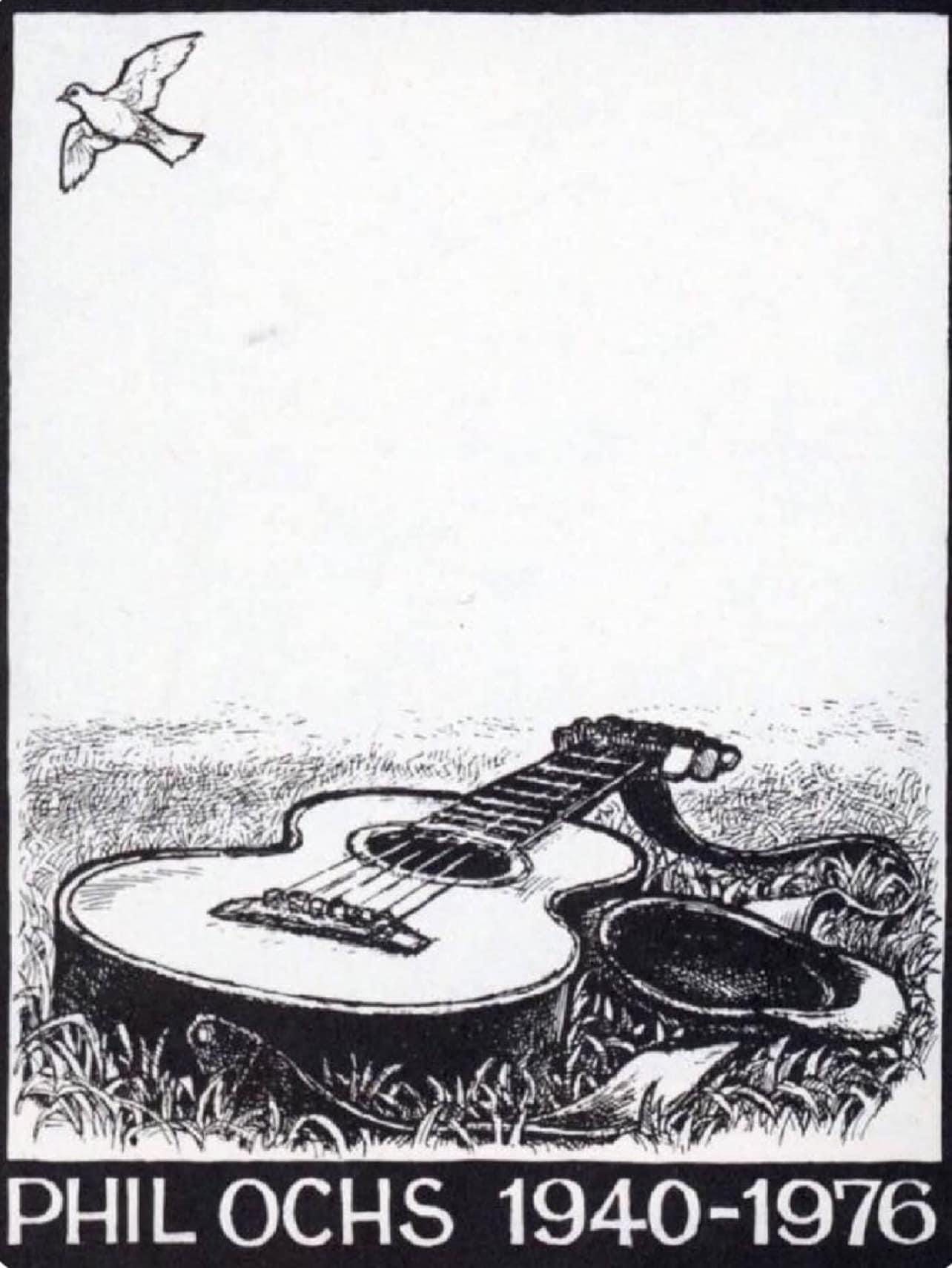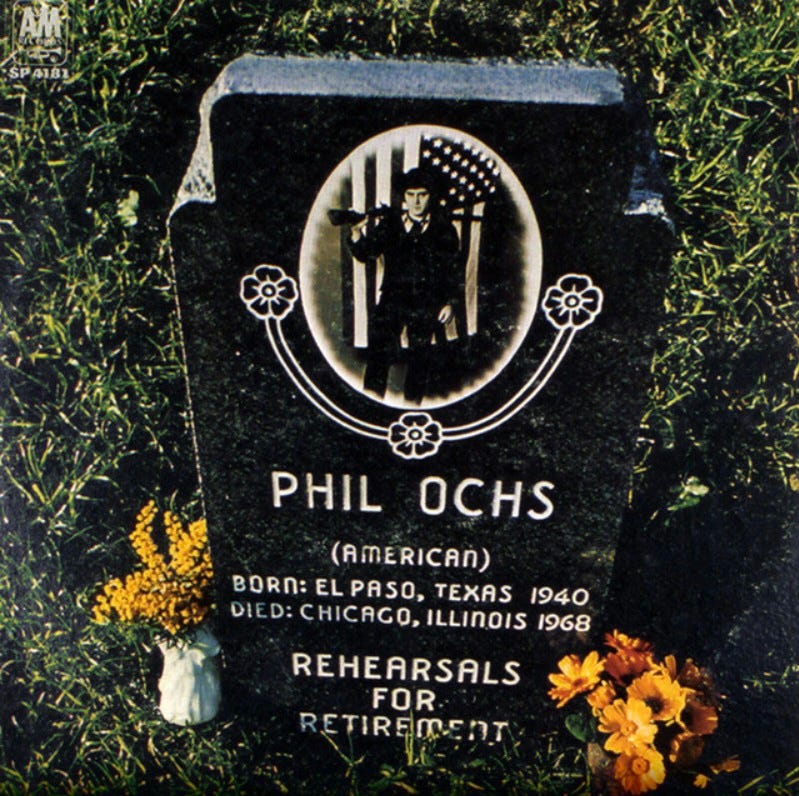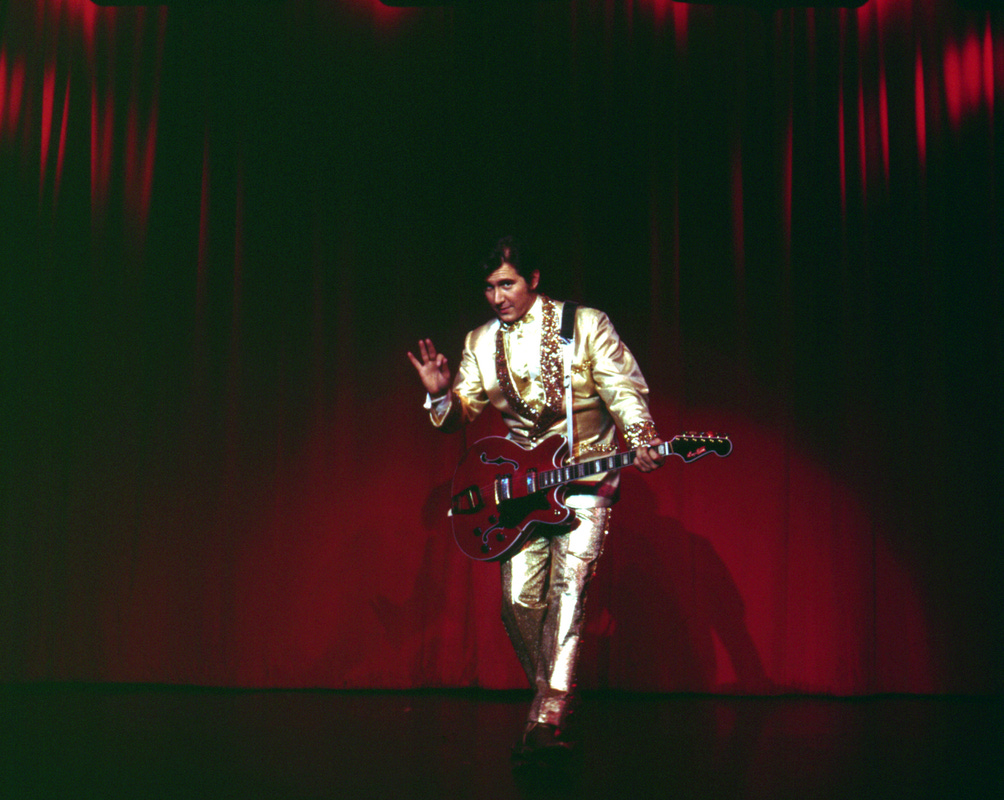May is Mental Health Awareness Month and in light of that, I wanted to write about Phil Ochs, a man who has become my hero in the last three years. I have been a fan since grad school and had awareness of him before that. I see parallels to my own life in his: both grew up in the Midwest, studied journalism at a Big Ten University, suffered trauma that destroyed their mental health and had their dreams of creating a better world crushed. He took his life at 35 and that could easily be my fate as well.
“So many people have tried to analyze the reasons behind his death. There's nothing to analyze. He could literally not bear living anymore so he chose to go to sleep. At least he left us a legacy — all the meaningful songs he managed to create while with us,” wrote Sonny Ochs in the program for the memorial concert held in memory of her brother, Phil.
The singer-songwriter finally had enough of life and ended it on April 9, 1976 when he hung himself in his sister’s bathroom.
At that point, he was a broken man, one ravaged by alcoholism, mental illness and a number of traumatic events.
One of those was the 1968 Democratic National Convention, where Ochs witnessed the brutality of the police towards protesters and saw his dreams of a better world snuffed out.
Rehearsals for Retirement was the album he recorded in response to what he experienced. The cover depicts his tombstone. At the top of the black marble is an image of Ochs standing with a rifle over his shoulder and wearing a cowboy hat. Behind him is the American flag.
Below was his name and in parentheses underneath (American) and listed next was his date of birth and date death.
Born: El Paso, Texas 1940
Died: Chicago, Illinois 1968
“The album would be his final statement: after seeing the week’s events in Chicago, he had no reason to sing or write anymore. All he had to live for had been beaten down by the very society he had hoped to turn around. He was as dead as the Movement itself.” —There But for Fortune: The Life of Phil Ochs by Michael Schumacher
The album title sadly proved to be self-fulfilling. For Ochs, the hurt got worse and the heart got harder.
“At the core of his depression was a deep-seeded rage that he directed toward everyone, including himself. He hated the present form of government and its leaders, who he felt were oppressive and murderous. The counterculture, he decided, was a bad joke; people like Jerry Rubin and Abbie Hoffman, though dedicated, had no clues about how to change America. Finally, he was angry at himself for believing that change was possible in the first place.”— There But for Fortune: The Life of Phil Ochs by Michael Schumacher
Something about the convention broke him. “My life was once a joy to me” and then “my life is now a death to me” as he puts it in “My Life,” the song that closes the first side of the album.
In the years that followed, Ochs was called on to testify at the trial of the Chicago 7 and his music took a new direction. He felt his current approach wasn’t working so he decided to return to the music he grew up with and loved as a means of reaching the public. The new album would see a shift to country and rock and roll.
“He had the entire concept worked out in his mind: to effect significant change in America, you had to be part Elvis Presley and part Che Guevara. As a topical songwriter and political activist, Phil had long ago established his revolutionary credentials; what he needed now was to make the Elvis connection. The Greatest Hits album had begun the process. The next stop would be to take the show on the road.” — There But for Fortune: The Life of Phil Ochs by Michael Schumacher
To that end, Ochs donned a gold lamé suit like the one worn by the King on the cover of 50,000,000 Elvis Fans Can’t Be Wrong. That gold suit, designed by tailor Nudie Cohn, would make an appearance on the cover of his final album, Greatest Hits. On the back of it was the phrase “50 Phil Ochs Fans Can’t Be Wrong.”
During the subsequent tour, Ochs would perform his own material as well as medleys of Elvis Presley and Buddy Holly. His audience wasn’t sure how to react. And while it wasn't quite the level of vitriol fans displayed when Bob Dylan went electric, many fans wanted to hear his older material and some were outright hostile towards the early rock and roll songs he played.
The most successful performance was recorded and released as Gunfight At Carnegie Hall, a recording that combined elements of two shows on March 27, 1970.
During one show, he explained to the crowd why he had donned the lamé suit.
“As you know, I died in Chicago. I lost my life and I went to heaven because I was very good and sang very lyrical songs. And I got to talk to God and he said, ‘Well, what do you want to do? You can go back and be anyone you want.’ So I thought who do I want to be? And I thought, I wanted to be the guy who was the King of Pop, the king of show business, Elvis Presley. If there’s any hope for America, it lies in a revolution. If there’s any hope for a revolution in America, it lies in getting Elvis Presley into becoming Che Guevera. If you don’t do that, you’re just beating your head against the wall, or the cop down the street will beat your head against the wall. We have to discover where he is, he’s the ultimate American artist.”
Gunfight At Carnegie Hall would not see the light of day until 1974. Greatest Hits ended up being his final album. The last three studio albums Ochs recorded were filled with hints, signs and portents of what was to come, the most stark being the tune that closes Greatest Hits: “No More Songs.” It’s easy to read the lyrics with hindsight and see the coming doom. The final verse may as well have been his epitaph.
Hello, hello, hello
Is there anybody home?
I've only called to say
I'm sorry
The drums are in the dawn
And all the voices gone
And it seems that there are
No more songs
It seems that there are
No more songs
It seems that there are
No more songs
There’s a brief exchange in the song’s outro that plays sadder knowing what was in store for him.
"Where will you be appearing, Phil?"
"Huh?"
"Will you be appearing anywhere?"
"Um, I dunno. I'll probably do, you know, doing a lot of moratorium stuff. I can't make the [?] things, I'll be in Hawaii. But uh, just touring here and there. I'll be around for a while.
Ochs took a trip to Chile in August 1971 and met folk singer Victor Jara. A year prior, Chile had elected the Marxist Salvador Allende president. Ochs very much admired Jara, whom he had initially been reluctant to meet. Jara was famous in Chile and had played a role in electing Allende.
During that trip in South America, Ochs drew the ire of local governments who did not care for left wing dissidents, whether homegrown or foreign. Ochs was arrested and detained after performing at a political rally in Uruguay. He spent time in an Argentinian prison and was sent to Bolivia, which is where the Argentinian government sent people like Ochs to disappear. The airline pilot prevented Bolivian government officials from getting on the plane and permitted Ochs to stay on the plane. The aircraft headed to Peru and Ochs returned to the U.S. out of fear that the Peruvian government might arrest him.
Ochs did more traveling, Australia and New Zealand in 1972 and Ethiopia, South Africa, Malawi, Tanzania and Kenya. It was in Tanzania where he was attacked by robbers. During the struggle, Ochs was strangled and his vocal cords were damaged. As a result, he lost top three notes of his vocal range. The attack only exacerbated his mental illness and Ochs feared that the attack might have been an act by the CIA.
Not an unreasonable point of view, the FBI monitored him and had over 400 pages of material about him and considered him potentially dangerous. While the CIA was not directly involved in the coup that ended the Allende presidency, they had suggested such an approach in the past and were not upset about removing a socialist government from the chessboard.
Allende killed himself during the attack on the presidential palace and Jara was one of too many martyrs rounded up by the Pinochet regime and imprisoned in Estadio Chile. He was tortured for days.
“The military had cut off his hands and dared him to play his guitar and sing; when he continued to sing, they knocked out his teeth and taunted him to sing again. Finally, when it was apparent that nothing would silence him, they shot him dead. His widow found his remains a week later, stacked in a pile of dead bodies in the morgue.” — There But for Fortune: The Life of Phil Ochs by Michael Schumacher
After Jara was shot, his body was pierced with more than 40 machine gun bullets and then displayed alongside the countless bodies of others murdered by the fascists.
Ochs did not learn about the coup until after he returned from Africa. He was enraged by the brutal murder of his friend and began organizing a concert to bring awareness to what had happened in Chile. Performers at “An Evening with Salvador Allende” included Pete Seeger, Arlo Guthrie, Dave Van Ronk and Bob Dylan.
The Vietnam War finally came to an end on April 30, 1975 and at a rally to mark the conclusion of the conflict, Ochs performed “The War Is Over.”
Ochs’ physical and mental health continued to decline, he took on a new identity during this period: John Butler Train. Ochs was suffering from dissociative identity disorder and always walked around armed, carrying a hammer, knife or lead pipe.
“By Phil's thinking, he had died a long time ago: he had died politically in Chicago in 1968 in the violence of the Democratic National Convention; he had died professionally in Africa a few years later when he had been strangled and felt that he could no longer sing; he had died spiritually when Chile had been overthrown and his friend Victor Jara had been brutally murdered; and, finally, he had died psychologically at the hands of John Train.”— There But for Fortune: The Life of Phil Ochs by Michael Schumacher
The final footage of Ochs in the 2011 documentary Phil Ochs: There But For Fortune is of him looking disheveled and erratic on the streets. In last months of his life at his sister’s house in Far Rockaway, New York, Ochs obsessively played his song “Jim Dean of Indiana,” a song about a Midwest boy who died far too young, just like the man who wrote it.








